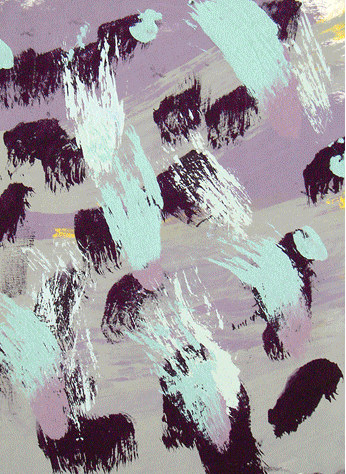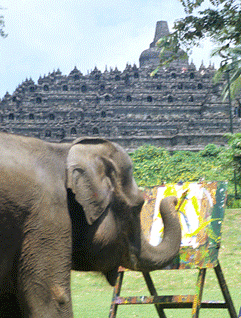 A pair of Russian artists ventured to Thailand, taught some elephants to paint and may have saved the species from extinction in the process.
A pair of Russian artists ventured to Thailand, taught some elephants to paint and may have saved the species from extinction in the process.
That was two years ago. Now, the paintings by these pachyderm Picassos hang in the toniest New York galleries, have been auctioned off at Christie’s and have earned thousands of dollars for the care of endangered elephants. Out this month, the coffee-table chronicle of this project, When Elephants Paint: The Quest of Two Russian Artists to Save the Elephants of Thailand—a hybrid art book, cautionary conservation tale, geography lesson and witty treatise on art philosophy—defies genre. Borders employees will suffer sleepless nights debating whether to display it on the ‘Art’ shelf or in the ‘Nature’ bin.
In 1900, more than 100,000 mild-mannered elephants wandered the tropical forests of Thailand, but today there are only about l,500 in the wild and 3,000 in captivity. The trouble is, deforestation and urbanization have left the untamed beasts with nowhere to live. Those in captivity, historically employed as beasts of burden, are mostly out of work nowadays due to the country’s 1989 ban on logging. Today, elephants that don’t earn a living in show business or giving rides to tourists actually meander the streets of Bangkok with their human masters (mahouts) and beg for money, trying to earn enough to satisfy their 500-pound-per-day food habit.
In 1995, this predicament caught the attention of mischievous Soviet expatriate artists Vitaly Komar and Alexander Melamid, who had until then made a living in the U.S. with stunts like selling Andy Warhol’s soul (for 30 rubles) and creating a series of “Most Wanted” paintings conceived after polling hundreds of citizens and combining all of their art preferences into one kitschy canvas per city. Each an accomplished artist in his own right, the duo had evolved into performance artists of a sort—art-world comedians who questioned the very nature of art. “Their high point was when they did the ‘Dark Paintings’ in the ’80s,” explains When Elephants Paint co-author Mia Fineman, a Yale-educated art historian who currently works in the Department of Photographs of New York’s Metropolitan Museum of Art. “A lot of these paintings included half-nostalgic, half-ironic representations of Stalin in the ‘Socialist Realism’ style, in which Komar and Melamid were trained. These paintings are all in museums now, but the two of them are still regarded as pranksters in the art world.”
Still, they are suckers for a good cause: Touched by the plight of the endangered elephants, the two hatched a philanthropic plan to teach elephants to paint—a fundraising tactic already employed by a number of American zoos—and create a market for their wares.
Here’s how it works: A giant canvas is laid on the ground in front of an elephant, who grips a paintbrush with the tip of his or her trunk. With the help of a mahout, who dips the brush in the paint, the elephant then drags the brush across the canvas. It turns out that each elephant develops his or her own distinctive style. Some do swirls; others execute aggressive strokes. Some prefer solid colors while others mix and blur the pigments. Some elephants will not stop until the entire paper is covered. Others are content with patterns and lines. Unlike monkeys, who will do just about anything you teach them to if you reward them with a banana, the elephants take to the task without rewards or coercion. In one instance, a 10-year-old bull named Bird actually sneaked out of his stall in the middle of the night, broke into the supply room, opened the paint and, without access to a brush, painted the elephant camp village’s buildings and trees with his trunk. Painting is a happy vocation for some of these students, it seems. And a lucrative one.
 But is it art? This may be the headiest question When Elephants Paint tackles. Many people will look at Modern art and snipe, “A monkey could have painted that.” Maybe one could—the elephants can. In fact, the book juxtaposes the work of pachyderm artists Juthanam, Lukkang, Bird and Lukkop with paintings by human forerunners Joan Mitchell, Vasily Kandinsky and Willem de Kooning. You’ll be hard-pressed to tell them apart.
But is it art? This may be the headiest question When Elephants Paint tackles. Many people will look at Modern art and snipe, “A monkey could have painted that.” Maybe one could—the elephants can. In fact, the book juxtaposes the work of pachyderm artists Juthanam, Lukkang, Bird and Lukkop with paintings by human forerunners Joan Mitchell, Vasily Kandinsky and Willem de Kooning. You’ll be hard-pressed to tell them apart.
A snapshot of 16-year-old elephant Renee laboring over a bedsheet-sized canvas just across the page from a photo of Jackson Pollock lurched over one of his splatter paintings may be there for comic effect, but it makes its point. “Abstract Expressionism is elephant painting,” Melamid explains. “Both are totally mindless occupations. Pollock, when he discovered drip painting, did he think about it? Even when I paint a realist painting, do I really think about what I’m doing? If you think about it, it shows, and it’s not good. Elephants are really the best Abstract Expressionists— they don’t think too much.”
Not surprisingly, Fineman reports that, “The elephant paintings are being regarded as a novelty and a joke, and by some people as a not very funny joke. People take what they’re doing very seriously and don’t appreciate a project that sticks its tongue out at everything art’s supposed to be about.”
But Fineman argues that this art is legit. “It’s legitimate from a formalist perspective and from the point of view of process, because they’re painted in a similar way,” she explains. “The elephants do approach the canvas in a direct and unmediated way. The image emerges through the process.”
Even if it is art by some criteria, the elephant oeuvre smacks of gimmickry. But Melamid, the prankster, has a reply for this: “There’s no difference between art and a gimmick,” he says. “There’s nothing real in art. Any discovery in art can be perceived as gimmick or a real spiritual discovery … in its own time. Maybe in 100 years Van Gogh won’t be considered a great artist any more.”
Call it gimmick, insult or Abstract Expressionism, people love the elephants’ paintings and the project just sent more than $25,000 back to Thailand. Interested collectors can pick one up for around $350 at www.elephantart.com. As for the book, it’s $40—a portion of which is earmarked to benefit the Asian Elephant Art and Conservation Project—and it’s available at amazon.com.
-ROB. WALTON

